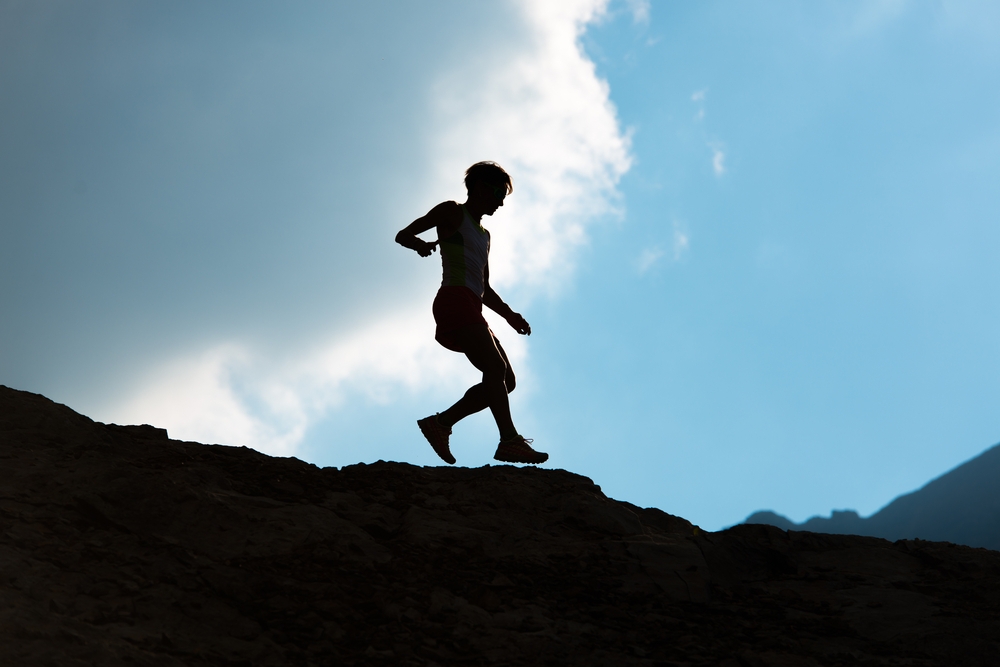Downhill running is an enemy in disguise to most trail runners. It can be a reprieve for the cardiovascular system and many see it as an opportunity to let loose and fly down the hill at full speed.
However, in trail races longer than half marathon distance, we need to be very wary of the downhill….

When running downhill, our quadriceps and calf muscles are working eccentrically (that is the muscle lengthens whilst under load). These eccentric contractions are known to damage our muscles significantly more than concentric contractions (muscle shortens whilst under load). Therefor downhill running can trash our quads and calves very quickly.
Downhills become particularly important for ultra distance events where becoming fatigued in your calves and quads early can be the difference between a PB and not finishing. Downhill running is a skill, so we recommend putting these strategies into place well before your next race.
Strategy 1: Downhill Running Technique
- Land on your mid-foot: If you land on your heel, you are applying the brakes with every step. This puts a lot more load through your quads and slows you down.
- Land under your centre of gravity: Your foot should land under your centre of gravity, if it is too far out in front you are again applying the brakes and unnecessarily loading your quads and knee joint.
- Lean into the hill: We naturally want to lean backward when running downhill, to protect ourselves. However, this applies the brakes and overworks our quads. The more you practice this, the more confident you will be leaning into the hill.
- Increase stride length and reduce cadence: This will happen naturally as you become more confident with running downhills at faster speeds.
- Keep your arms out wider for balance: The steeper the hill, the more relevant this is. If you are running very steep downhills, your arms should be relaxed and out wide (imagine zooming down the hill like an aeroplane).
Strategy 2: Practice Downhill Running
Specific practice is important for any sport and running is no different. By practicing downhill running, the neuro-musclar system will slowly adapt, increasing the muscles capacity to attenuate these loads. We recommend practicing downhills during the building phase of your running program for all runners. If you are running an event with a lot of downhills, you will need to complete at least 2-3 specific downhill training sessions closer to the event.
When planning your downhill running session, ensure you adapt it to the race you are competing in. If your race involves running down a lot of steps, train on the steps. If it involves downhill running on slopped fire trail, train on fire trail. Being specific with your training is important, especially as you get closer to a race.
Some sample downhill running sessions include:
- Beginner: 10 x 10 second downhill running with a walk back up hill. Focus on the above running technique tips. Aim to increase your speed with each repetition, as your confidence grows.
- Intermediate: Hilly Fartlek: Choose an undulating running course for 20-40 minutes. Run at a steady pace for all flat and uphill sections, run a hard effort (7-9/10 RPE) on every downhill.
- Long Downhills: Find a long downhill of at least 1 minute and up to 5 minutes. Repeat the long downhill 4-10 times at a hard effort (7-9/10 RPE). Walk back up hill and repeat. Focus on the above hill running technique, aiming to run hard but have a nice relaxed body.

Strategy 3: Strength Training for Quads and Calves
Strength training is important for all runners, not just downhill running. Heading to the gym and completing eccentric training of the calves and quads will dramatically increase the distance you can run before your legs become trashed and you slow down. It is particularly important to focus on the eccentric component of these exercises, as this is how the muscle moves when running. Exercises for the calves should include weighted seated and standing calf raises (focus on quick concentric and slow eccentric contractions). Exercises for quads can include exercise such as weighted Bulgarian split squats, front bar squats, reverse nordics, Step ups/downs, Spanish squats. Contact us for run coaching as we tailor strength programs for all our runners